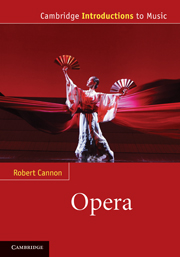Book contents
- Frontmatter
- Contents
- Tables
- Introduction
- Part I The seventeenth and eighteenth centuries
- Part II The nineteenth century
- Chapter 7 Romanticism and Romantic opera in Germany
- Chapter 8 Opera in nineteenth-century Italy
- Chapter 9 Grand opéra and the visual language of opera
- Chapter 10 The Wagnerian revolution
- Chapter 11 Nationalists: vernacular language and music
- Chapter 12 The role of the singer
- Part III The twentieth and twenty-first centuries
- Appendix 1 Motifs from The Ring used in Chapter 10
- Appendix 2 The development of singing voices in opera
- Appendix 3 The development of lyric theatre alternatives to ‘opera’
- Appendix 4 Some major operas and artistic and political events of the twentieth century, 1899--2008
- Glossary of key terms
- Notes
- Bibliography
- Index
Chapter 8 - Opera in nineteenth-century Italy
from Part II - The nineteenth century
Published online by Cambridge University Press: 05 June 2012
- Frontmatter
- Contents
- Tables
- Introduction
- Part I The seventeenth and eighteenth centuries
- Part II The nineteenth century
- Chapter 7 Romanticism and Romantic opera in Germany
- Chapter 8 Opera in nineteenth-century Italy
- Chapter 9 Grand opéra and the visual language of opera
- Chapter 10 The Wagnerian revolution
- Chapter 11 Nationalists: vernacular language and music
- Chapter 12 The role of the singer
- Part III The twentieth and twenty-first centuries
- Appendix 1 Motifs from The Ring used in Chapter 10
- Appendix 2 The development of singing voices in opera
- Appendix 3 The development of lyric theatre alternatives to ‘opera’
- Appendix 4 Some major operas and artistic and political events of the twentieth century, 1899--2008
- Glossary of key terms
- Notes
- Bibliography
- Index
Summary
The challenge of integrated operatic form
As in Germany, Italian composers were faced with the problem of how to create a coherent musico-dramatic whole from disparate elements. While the Italians did not have the problem of the Singspiel's alternating song and speech, it had always alternated between recitative and aria. This became exacerbated with the emphasis on virtuosic and melodic writing, which risked overwhelming the needs of the drama. It was against this background that opera of the primo ottocento (early nineteenth century) developed.
At the 1815 Congress of Vienna, the arch-reactionary Metternich had been told that Italy was Austria's affair (see Duggan, 2008: 74). The consequent repression meant that public political life and debate were virtually impossible. Where they did exist, in the movement towards the Risorgimento, they were radical and outside mainstream circles, secretive and often conducted in exile. This was reflected in the public arts, so that intellectual life had no public arena where the pressing issues of freedom and national unity could be addressed. In addition, Italy's lack of raw materials meant that industrialisation occurred late in the century, so that the independent bourgeoisie, who were so active in France, England and Germany, remained part of the Austrian-dominated world, reinforcing the role of the arts as entertainment and escape rather than becoming a force for change.
- Type
- Chapter
- Information
- Opera , pp. 127 - 168Publisher: Cambridge University PressPrint publication year: 2012

